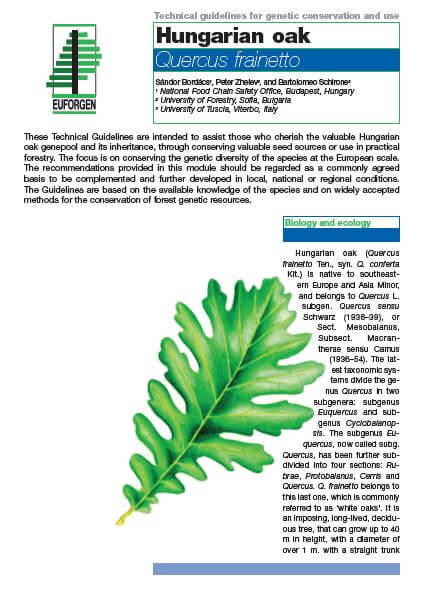Quercus pubescens - Technical guidelines for genetic conservation of Pubescent oak
Similarly to other related oak species, in situ conservation methods should generally be preferred also for Q. pubescens. Pubescent oak grows well in a high-forest system which would by itself be an effective measure for species protection. Nevertheless, due to its good resprouting ability, the coppice system has been predominantly used for ages. Decrease of genetic resources is a serious risk when concentrating exclusively on coppices. This system, with 1000–2000 stumps/ha, coppicing rotations of about 30–50 years and preserving at least 80 seed-bearing trees/ha, is suggested for small private farms, and where the soils are degraded, or with incompletely favourable ecological conditions.
Coppice conversion to high forests requires 170–200 seed-bearing trees/ha. A good compromise would be to leave 80–130 stumps with just one single stem and adopt longer rotations for coppicing (50–80 years).
When artificial regeneration is carried out according to the principles of genetic conservation, then the following requirements for the use of reproductive material must be observed:
- Preference should always be given to local material, unless results from provenance trials point to inferior quality or growth characteristics in the local population. Local material usually guarantees retention of the evolutionary and adaptive characteristics that have developed at a given site under specific conditions over generations. Lack of adaptability can lead to serious failures at any stage of the long lifespan of oaks and other forest tree species.
- If there is no local material available or if there are signs of inbreeding, then restoration may rely on the introduction of material from outside. Material from localities sharing the site conditions with the regeneration site should be preferred.
If in situ methods are not sufficient, additionally, ex situ conservation programmes should be used as well in order to preserve the endangered gene pool. Ex situ programmes should be adapted and specified to the local conditions to incorporate genetic conservation criteria into forestry management in order to guarantee the genetic quality of the materials used in plantations.
Pubescent oak might have an increasing role in its present and potential future distributional range, due to its adaptive potential. The forest-steppe and sub-mediterranean climate is predicted to be the dominant climate in some regions of Central Europe. In such climatic belts the forests are usually composed of Q. pubescens s.l. and/or its natural hybrids. Since limited genetic information about Q. pubescens is available, it is recommended that genetic conservation programmes start with the following objectives: conservation of endangered, marginal populations and habitats of Q. pubescens; sampling the genetic diversity; establishment of Dynamic Conservation Units based on long term autochthony, high biodiversity value and location in ecologically diverse regions of large populations (> 1000 individuals).
Authors: Sándor Bordács; Peter Zhelev Stoyanov; Bartolomeo Schirone
Journal/Series:
EUFORGEN Technical Guidelines for Genetic Conservation and Use
Publication Year: 2019
Publication Format: PDF
ISBN 13: 978-952-5980-63-9
Language: EN
Pages: 6 p.
Technical guidelines Quercus pubescens

